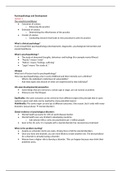Psychopathology and Development
Lecture 1
The scientist practitioner
Consumer of science
o Enhancing the practice
Evaluator of science
o Determining the effectiveness of the practice
Creator of science
o Conducting research that leads to new procedures useful in practice
What is clinical psychology?
A very broad field: psychopathology (development), diagnostics, psychological intervention and
mental healthcare.
What is psychopathology?
The study of abnormal thoughts, behaviour and feelings (for example mental illness)
“Psycho” means “mind”
“Pathos” means “feelings, suffering”
“Logia” means “the study of..”
Lifespan
What sort of factors lead to psychopathology?
How may psychopathology arise in early childhood and then intensify over a lifetime?
- What is the individual’s initial level of vulnerability?
- And what types and amount of stress are experienced by that individual?
Life-span developmental perspective
Some things that are normal at a certain age or stage, are not normal at another.
Stressors over the lifespan:
Equifinality: the same outcome can be arrived at from different origins (the principle that in open
systems a given end state can be reached by many potential means)
Multifinality: The same origin can end up at different outcomes. One reason, but it ends with many
disorders (sexual abuse mental disorder).
Global incidence of psychological disorders
Mental health accounts for 13% of world disease burden
Mental health care very limited in developing countries
o Sub-saharan Africa: only one psychiatrist per 2 million people
Even in the US, only 1 in 3 people with a mental disorder has received any treatment
When is the problem starting?
Anxiety as a disorder starts very early, driving force of all the mental disorders.
Once you have one disorder, you are more likely to create another one. The best predictor
for a disorder is already having a disorder.
Women have a higher risk to develop a disorder. This can happen because men drink their
problems away.
,How can we define a psychological disorder? (What is normal – what is abnormal?)
Categorical: healthy X ill
Typological: healthy/ill
Dimensional: healthy -> ill
The dangers of the “medical model”
Focus on internal instead of external causes, mainly mono causal models
Not enough emphasis on the own responsibility of the patient
Focus is more directed to therapy than prevention, fighting against the disease instead of
health-advancement
Preference for “biological/somatic” therapies “Disease” sounds worse than psychological
disorder.
If we say something is medical, it’s out of our hands.
If we say something is biological, we get rid of the stigmatisation. But we also look for a biological
cure, but for many a psychotherapy is better than medication.
Multidimensional space: Disorders do not fit reality. That’s why diagnoses change every few years.
Statistical infrequency
Abnormal behaviour is often infrequent? mania & depression occur in 1% of the
population.
But anxiety in 20-30%...
60% gets a disorder
The problem: unusual behaviour is not abnormal (60%)
When is it a disorder?
Violation of social norms
Abnormal behaviour often violates the social norms of a given culture (e.g. experiencing and
acting upon hallucinations, talking to inanimate objects)
It’s a relative concept and it changes from culture
First, homosexuality was seen as a disorder, but now it’s just behaviour.
The meaning of a disorder differs for every culture. When you’re in love with your shoe,
you don’t harm anyone, is it a disorder?
Subjective: personal distress
Behaviour or feelings may be abnormal if it creates great distress (e.g. people with depression
experience considerable distress).
BUT: not all distressed individuals are mentally ill
People with an eating disorder are happy that they’re losing weight, even though it is not
good for them.
Dysfunction
, Does the behaviour impair an individual’s ability to function in life (school, work, personal
relationships?) E.g. substance-use disorders
Problem: some individuals with an actual diagnosis, live functional lives. Some do not
function, but also do not have a disorder.
Works the best. But it’s culture-dependent: what is normal life?
THUS: several factors need to be taken into account to determine what is abnormal and can
accordingly be considered as psychopathology.
Psychological disorder:
Psychological dysfunction
Distress or impairment
Atypical response (the behaviour/cognition/emotions are off)
How does DSM define it? – and are there better ways?
A disturbance in an individual’s cognition, emotion or behaviour that reflects a dysfunction in
the psychological, biological or developmental processes underlying mental functioning.
Mental disorders are usually associated with significant distress in social, occupational, or
other important activities
Socially deviant behaviour and conflicts that are primarily between the individual and society
are NOT mental disorders.
The borders are vague. What if you are depressed for 13 days, but the DSM says you
have to be depressive for at least 14 days?
The “Rosenhan study”
The Rosenhan experiment was an experiment conducted to determine the validity of psychiatric
diagnosis. The experimenters feigned hallucinations to enter psychiatric hospitals, and acted
normally afterwards. They were diagnosed with psychiatric disorders and were given antipsychotic
drugs. The second part of his study involved an offended hospital administration challenging
Rosenhan to send pseudopatients to its facility, whom its staff would then detect. Rosenhan agreed
and in the following weeks out of 250 new patients the staff identified 41 as potential
pseudopatients, with 2 of these receiving suspicion from at least one psychiatrist and one other staff
member. In fact, Rosenhan had sent no pseudopatients to the hospital.
What we have learned:
o There have to be rules to diagnose someone.
o The psychiatrist were rotten; they didn’t pay enough attention to the patients.
o Context: in the psychiatric context it’s harder to distinguish the psychiatric from the
non-psychiatric.
Why do we diagnose or classify?
1. Accurate description
2. Prediction
3. Intervention
Arguments against classification
Typologies can “hide” basic dimensions
Confusion description and explanation
Losing information due to “labels”
Stigmatizing due to labeling
Arguments pro classification
, Communication (standardized)
Organization and reduction of information
Efficient transfer of information
Basis for the accumulation of knowledge (treatment, research)
Instructions for clinical diagnostics and therapy
Explicit classification is better than implicit classification
NIMH Strategical Plan: RDoc
Develop, for research purposes, new ways of classifying mental disorders based on dimensions of
observable behaviour and neurobiological measures.
Focused on five domains:
Negative valence
Positive valence
Cognitive systems
Systems for social processes
Arousal/regulatory systems
Clinical Interviews
Can be structured as well as unstructured
In an unstructured interview, the clinician asks mostly open questions
In a structured interview, the clinician asks prepared questions, often based on a published
interview
Can contain a “mental status exam”
The goal of the interview? Inform treatment:
A therapeutic decision must be based on knowledge of the disorder and change
The steps in the therapy should have a plan and a goal
The professional psychotherapist is critical: evaluation of the own procedure
Therapeutic decisions must be scientifically justified
Diagnosis
Is more than an interview:
Interview (classification)
Background information (history, stressors, context)
Questionnaires
Behaviour analyses…
Observations






